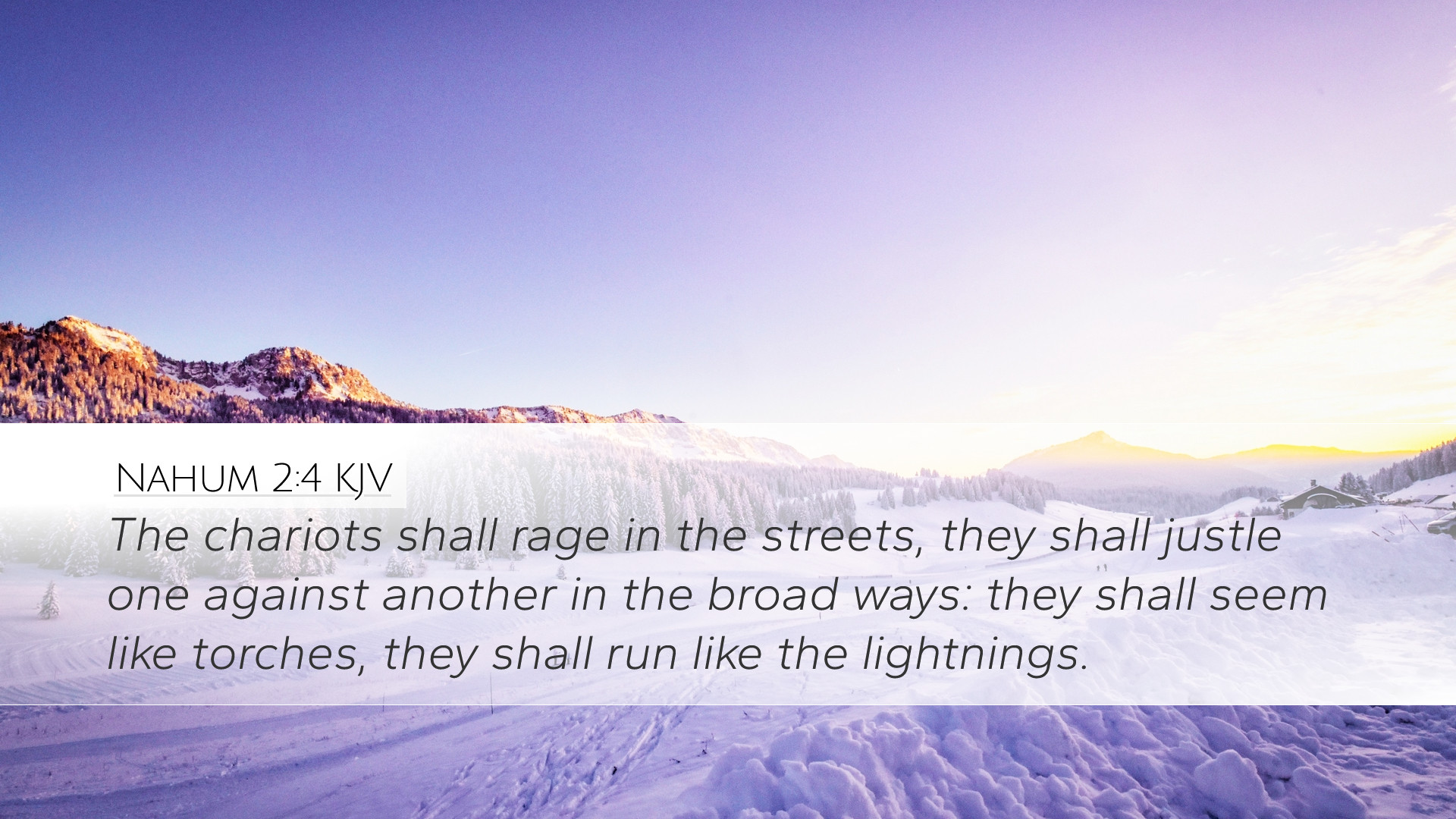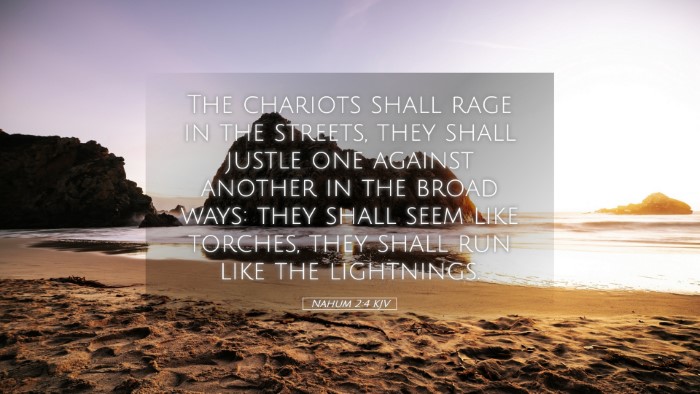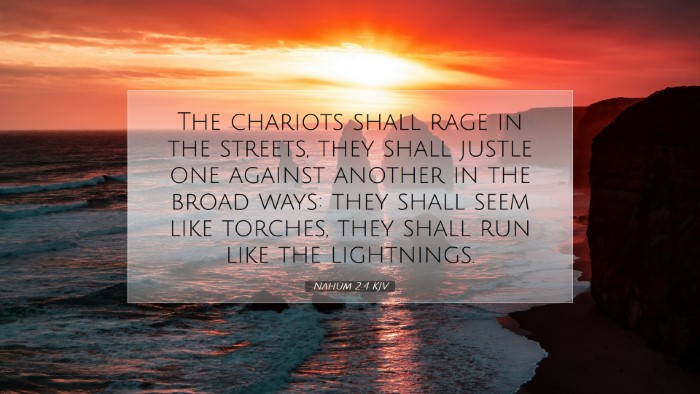Old Testament
Genesis Exodus Leviticus Numbers Deuteronomy Joshua Judges Ruth 1 Samuel 2 Samuel 1 Kings 2 Kings 1 Chronicles 2 Chronicles Ezra Nehemiah Esther Job Psalms Proverbs Ecclesiastes Song of Solomon Isaiah Jeremiah Lamentations Ezekiel Daniel Hosea Joel Amos Obadiah Jonah Micah Nahum Habakkuk Zephaniah Haggai Zechariah MalachiNahum 2:4
Nahum 2:4 KJV
The chariots shall rage in the streets, they shall justle one against another in the broad ways: they shall seem like torches, they shall run like the lightnings.
Nahum 2:4 Bible Commentary
Bible Commentary on Nahum 2:4
Nahum 2:4 states, "The chariots shall rage in the streets, they shall justle one against another in the broad ways: they shall seem like torches, they shall run like the lightning." This verse from the prophetic book of Nahum paints a vivid and intense picture of the chaos and destruction that would befall Nineveh, the capital city of Assyria. For pastors, students, theologians, and Bible scholars, this verse provides essential insights into divine judgment and the prophetic imagery that conveys God's sovereignty and justice.
Overview and Context
Nahum prophesied during a time of impending doom for Nineveh, which had been a formidable enemy of Israel. The Assyrian Empire was known for its brutal military actions and oppression. The book of Nahum serves as an oracle against Nineveh, foretelling its downfall. As one considers Nahum 2:4, it is crucial to understand both the historical context and the literary devices used in prophetic literature.
Exegesis of Nahum 2:4
In this verse, Nahum employs vivid imagery to convey the frenetic activity of the approaching enemy and the destruction of Nineveh:
- Chariots in the Streets: The mention of chariots illustrates the might of the invading army. The clamor and chaos of warfare engulfing the streets symbolize the overwhelming force against Nineveh, which once revelled in its military power.
- Justling Against One Another: The phrase 'justle one against another' suggests disorder and confusion amid combat. It reflects the turmoil that befalls a city under siege, where even the forces that are meant to fight together become disordered due to panic.
- Seem Like Torches: This vivid imagery evokes the brightness and swiftness of the invading forces. The chariots appearing as torches may symbolize both destruction and illumination, as the fire of war shall expose Nineveh’s sins and bring judgment.
- Run Like Lightning: This simile signifies the swiftness and inevitability of the destruction that is coming upon Nineveh. Lightning is sudden and uncontrollable, paralleling God's judgment that breaks forth unexpectedly.
Theological Implications
This verse serves several theological purposes:
- God's Sovereignty: The imagery in Nahum 2:4 reflects the reality that God is sovereign over the nations. While Nineveh once wielded great power, the prophecy emphasizes that ultimate control belongs to God, who utilizes nations to fulfill His purposes.
- Divine Judgment: The depiction of chaos foreshadows judgment against sin. Nineveh's violent and oppressive actions angered God, and as such, the prophecy illustrates that divine justice is inevitable, aligning with the broader theme of God's intolerance for sin.
- Hope for the Oppressed: For the Israelites, this prophecy offers comfort and hope. The promise of judgment against their oppressors reassures them of God’s active involvement in their history, reminding them that He does not overlook injustice.
Commentary Insights
Matthew Henry
Matthew Henry provides a practical and pastoral insight that emphasizes the inevitability of divine judgment. He notes that those who trust in God should have no fear of worldly powers since the Lord will render justice in His time. Henry also points out that the destruction of Nineveh serves as a warning: sin leads to significant consequences.
Albert Barnes
Albert Barnes expounds upon the metaphor of the chariots, observing that the imagery conveys swift destruction. He comments on the utter disarray that will accompany Nineveh’s demise, highlighting that the nation will become a scene of distress rather than glory. Barnes reminds the reader that this foreshadows the end of all earthly power that stands in opposition to God.
Adam Clarke
Adam Clarke focuses on the metaphorical significance of the chariots appearing like lightning. He interprets this as God’s judgment being executed with speed and clarity. Clarke further emphasizes the universal principle that those who engage in oppression and evil will ultimately be held accountable for their actions, encouraging us to reflect on the consequences of societal sin.
Contemporary Application
For contemporary readers, Nahum 2:4 serves as a powerful reminder of the nature of sin and its repercussions. The imagery calls for self-reflection in both personal and communal contexts:
- Recognition of Sin: It prompts individuals and societies to evaluate their lives against God's standards. The chaos portrayed is symbolic of the disorder that arises from ignoring divine principles.
- Hope in God’s Justice: Believers can find solace in the assurance that God sees the injustices in the world and will act against them in His timing. This should encourage a commitment to righteousness and advocacy for justice.
- Urgency of Repentance: The swift nature of impending judgment also emphasizes the need for repentance. Just as Nahum warned Nineveh, today's generation is called to turn back to God before consequences unfold.
Conclusion
Nahum 2:4 encapsulates the essence of divine judgment while providing profound theological insights applicable for all believers. The imagery serves not only as a historical account of Nineveh's downfall but also stands as a timeless warning against the dangers of sin and the faithful assurance of God's ultimate justice. As one reflects on this verse, it becomes a rich source for theological reflection, pastoral care, and encouragement in the pursuit of justice and holiness in a world that often resembles the chaos of Nineveh.


